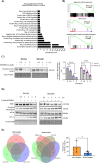Analysis of autophagy in DLBCL reveals subtype-specific differences and the preferential targeting of ULK1 inhibition in GCB-DLBCL provides a rationale as a new therapeutic approach
- PMID: 38263431
- PMCID: PMC10844068
- DOI: 10.1038/s41375-024-02147-4
Analysis of autophagy in DLBCL reveals subtype-specific differences and the preferential targeting of ULK1 inhibition in GCB-DLBCL provides a rationale as a new therapeutic approach
Conflict of interest statement
Andrew Davies:
Figures


Similar articles
-
Different predictive values of interim 18F-FDG PET/CT in germinal center like and non-germinal center like diffuse large B-cell lymphoma.Ann Nucl Med. 2017 Jan;31(1):1-11. doi: 10.1007/s12149-016-1123-6. Epub 2016 Sep 15. Ann Nucl Med. 2017. PMID: 27627889
-
CD47 Expression Defines Efficacy of Rituximab with CHOP in Non-Germinal Center B-cell (Non-GCB) Diffuse Large B-cell Lymphoma Patients (DLBCL), but Not in GCB DLBCL.Cancer Immunol Res. 2019 Oct;7(10):1663-1671. doi: 10.1158/2326-6066.CIR-18-0781. Epub 2019 Aug 13. Cancer Immunol Res. 2019. PMID: 31409608
-
Non-germinal center B-cell subtype of pediatric diffuse large B-cell lymphoma in Japan: A retrospective cohort study.Pediatr Blood Cancer. 2023 May;70(5):e30279. doi: 10.1002/pbc.30279. Epub 2023 Mar 1. Pediatr Blood Cancer. 2023. PMID: 36860130
-
Diffuse large B-cell lymphoma.Pathology. 2018 Jan;50(1):74-87. doi: 10.1016/j.pathol.2017.09.006. Epub 2017 Nov 20. Pathology. 2018. PMID: 29167021 Review.
-
Treatment approach to newly diagnosed diffuse large B-cell lymphoma.Semin Hematol. 2015 Apr;52(2):107-18. doi: 10.1053/j.seminhematol.2015.01.001. Epub 2015 Jan 15. Semin Hematol. 2015. PMID: 25805590 Review.
Cited by
-
Tumor Biology Hides Novel Therapeutic Approaches to Diffuse Large B-Cell Lymphoma: A Narrative Review.Int J Mol Sci. 2024 Oct 23;25(21):11384. doi: 10.3390/ijms252111384. Int J Mol Sci. 2024. PMID: 39518937 Free PMC article. Review.
-
Biomarker potential of nuclear Nrf2 activation in the ABC subtype of diffuse large B‑cell lymphoma.Oncol Lett. 2024 Oct 25;29(1):30. doi: 10.3892/ol.2024.14776. eCollection 2025 Jan. Oncol Lett. 2024. PMID: 39512504 Free PMC article.
-
Crosstalk Between Autophagy and Oxidative Stress in Hematological Malignancies: Mechanisms, Implications, and Therapeutic Potential.Antioxidants (Basel). 2025 Feb 25;14(3):264. doi: 10.3390/antiox14030264. Antioxidants (Basel). 2025. PMID: 40227235 Free PMC article. Review.
-
Mycobacterial antigen Ag85B restrains Hodgkin lymphoma tumor growth by inhibiting autophagy.Oncol Res. 2025 Apr 18;33(5):1173-1187. doi: 10.32604/or.2025.057842. eCollection 2025. Oncol Res. 2025. PMID: 40296899 Free PMC article.
-
Galectin-9 treatment is cytotoxic for B cell lymphoma by disrupting autophagy.Front Pharmacol. 2025 Jun 26;16:1601235. doi: 10.3389/fphar.2025.1601235. eCollection 2025. Front Pharmacol. 2025. PMID: 40641998 Free PMC article.

